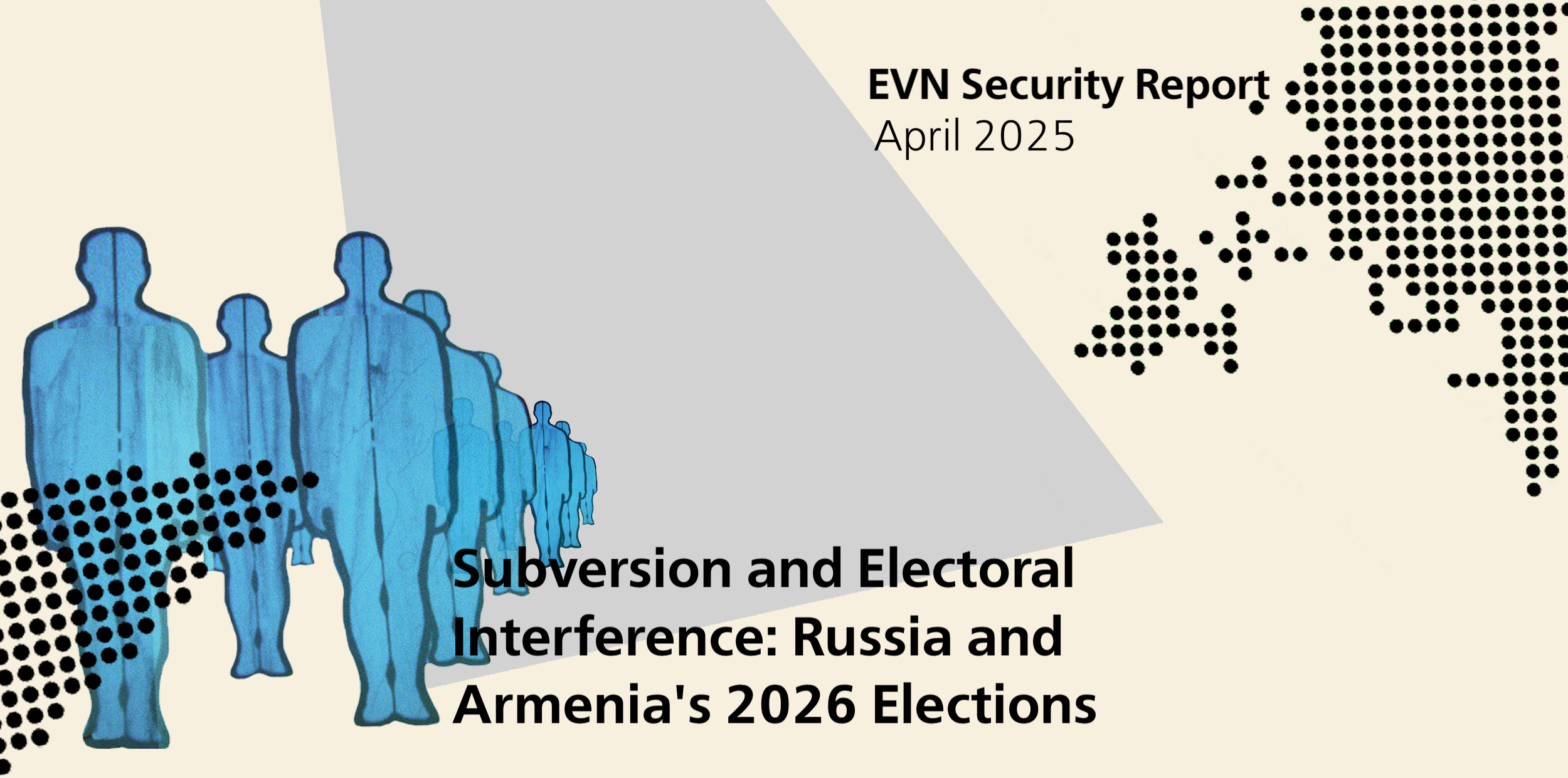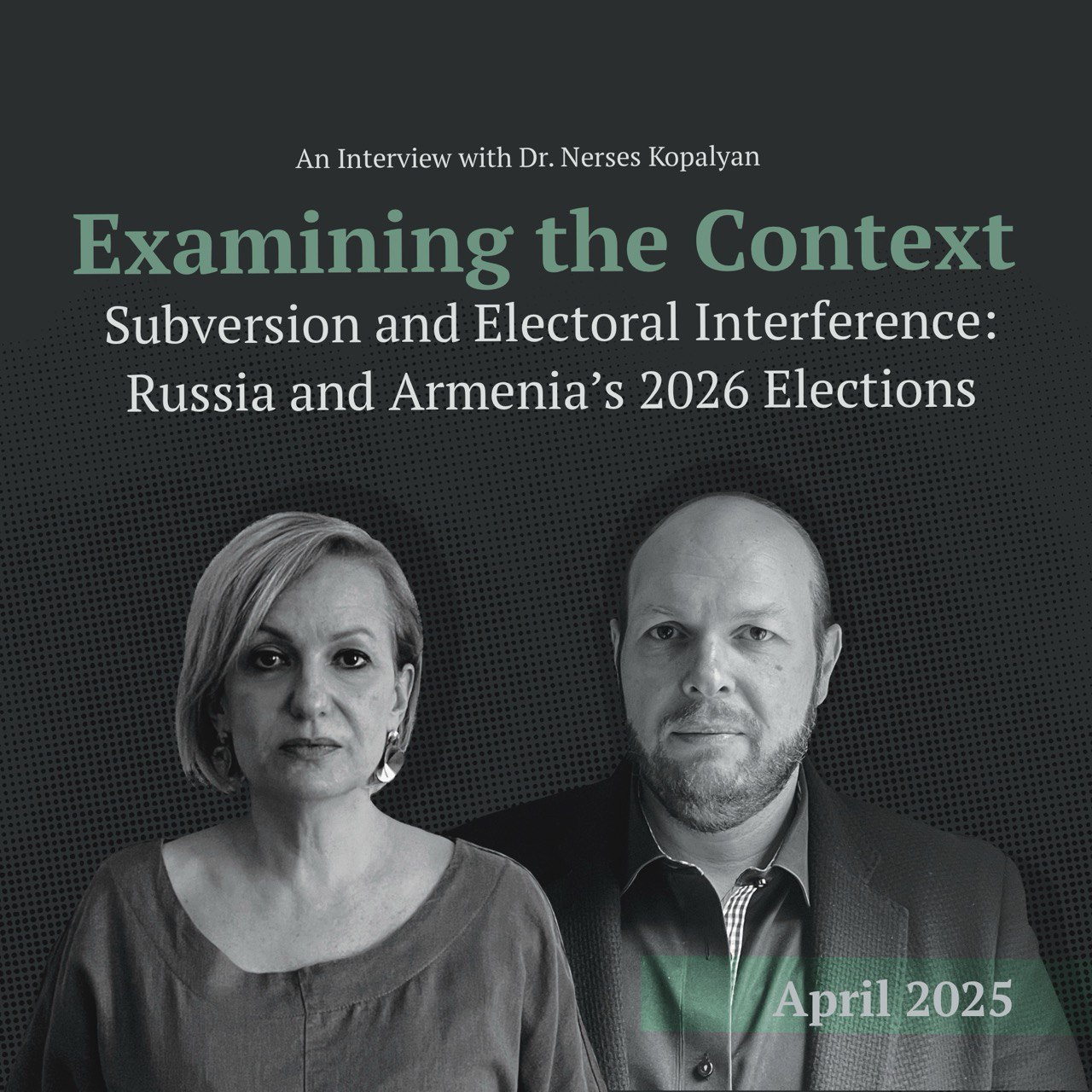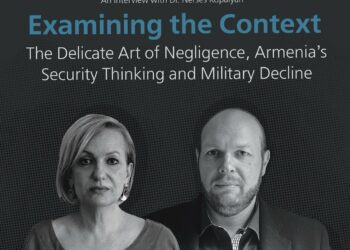Listen to the EVN Security Report.
In the aftermath of the 2020 Karabakh War, successive shocks to Armenia’s security environment have fostered a more complex and multifaceted societal understanding of the various levels of threats confronting the country. While physical security dominated thinking from 2020 to 2023, congruent hybrid attacks, information warfare, and kinetic diplomacy have exposed Armenian society to a conceptualization of security that goes over and beyond physical security. Indeed, physical security remains the dominant priority of any vulnerable society, but for Armenia, the variables shaping its security configurations slowly shifted after 2023: shocks to its system, either through hybrid operations or long-term information warfare, have become just as acute as physical threats.
In the domain of physical security, Azerbaijan remains the singular culprit. In the domain of hybrid operations and long-term information warfare, Russia poses the most acute threat. Almost the entirety of Armenia’s resources, and for understandable reasons, have been applied to the former. But since 2024, Armenia has slowly been concentrating on the latter, and with the pending parliamentary elections in 2026, greater attempts at shocking and destabilizing Armenia’s system of governance and its socio-institutional functions will come from Russia. Considering Russia’s expansive toolkit in such operations, and noting the vulnerabilities of small post-Soviet states that are transitional democracies, elections provide fertile ground for Russia to maximize its destabilization operations. To understand what Armenia may potentially be facing in 2026, the case study of what Russia did to Moldova in 2024 serves as an important empirical inquiry into Russian operations, and just as importantly, how to counter and de-hybridize such operations.
Russia’s endeavor of interfering and destabilizing the electoral field in Armenia is an open secret—from its loose involvement in the 2021 parliamentary elections to supporting the anti-democratic Armenia Alliance of Robert Kocharyan or the recent mayoral elections in Gyumri, as the pro-Russia candidate espoused emulating Belarus and joining Russia in a union state. The question, however, is not whether Russia will interfere or not, but rather, what would the magnitude of its interference be? In essence, what will be the degree and scope of resources that Russia allocates to rupture and destabilize Armenia’s nascent democracy in the 2026 parliamentary elections? While Russia will initially tread carefully, the work, however, has already begun.
The Kremlin’s Elite Team
The Moscow Times reported that the Kremlin will be “ramping up efforts to reasserts its influence in Armenia ahead of the country’s 2026 parliamentary elections,” with the initiative being overseen by the Kremlin’s domestic policy chief Sergei Kiriyenko, who is the First Deputy Chief of the Presidential Administration. Kiriyenko’s prior assignments included, among other strategically administrative responsibilities, “managing” elections in Abkhazia, South Ossetia, and Moldova. From a strategic perspective, he is delegated by the Kremlin to ensure the “implementation” of Russia’s state interests by operationalizing “informational rather than electoral” work in Armenia. Included in Kiriyenko’s team are Andrei Yarin, Head of the Internal Politics Department, Alexander Kharichev of the Department for the Monitoring and Analysis of Social Processes, and Sergei Novikov of the Department of Public Projects. In the domain of hybrid operations, the levels of expertise and areas of concentration of each of these departments, and the fact that they comprise the team that will be working on Armenia, is quite telling.
Overseeing the self-proclaimed Donetsk and Luhansk People’s Republics in the presidential administration, Kiriyenko is a strategist and tactician within the domain of grey zone operations, and while he has an image as an astute technocrat, he is, in essence, the Kremlin’s chief political officer in delivering election results. In Kiriyenko’s Internal Politics Department (UVP), Andrei Yarin, with close ties to the security apparatus, especially the FSB, is responsible for developing strategic plans in influencing electoral processes, whether plebiscites or election campaigns. Heading the Department for Monitoring and Analysis of Social Processes, which is a euphemism for ensuring that the electoral agenda of the State Council is implemented, is Kiriyenko’s confidant Alexander Kharichev, whose primary responsibility is to organize “election campaigns for pro-Kremlin candidates” and support the development of ideological doctrines that can be operationalized to meet such objectives. Kharichev, under Kiriyenko’s tutelage, oversaw Russia’s 2018 presidential elections, the 2020 constitutional referendum, the 2021 Duma elections, numerous gubernatorial campaigns, and the referendums in Luhansk and Donetsk. Needless to say, the results were consistent with the expectations of the Kremlin.
Moscow, in no uncertain terms, has assigned its elite team to influence, destabilize, and effect the 2026 parliamentary elections in Armenia. And its weapon of choice will be the concept of “corporate mobilization,” which Kiriyenko introduced in 2018. Corporate mobilization is the mechanism of both directly and indirectly mobilizing employees of businesses, companies, and large corporations to vote according to the expressed or implied interests of their employers. For the Kremlin, this mechanism of systematized voter fraud offers plausible deniability, while at the same time harming the democratic process or the ability of democratic institutions to sufficiently account for such processes. Corporate mobilization domestically (such as within Russian elections or plebiscites) is different from corporate mobilization externally (such as in targeted countries).
In the case of Armenia, as an externally targeted country, Moscow faces the conundrum of having lost immense soft power and social capital in the country. It also realizes that the pro-Russia political parties and factions, from Robert Kocharyan’s alliance of illiberal groupings to Serzh Sargsyan’s Republican Party to the inept Armenian Revolutionary Federation to the struggling Prosperous Armenia Party, are electorally impotent. Thus, the weaponization of Armenia’s illiberal opposition will be counterproductive within the electoral domain, but productive, from Russia’s lens, in enhancing destabilization efforts. But to the point on corporate mobilization: lacking the toolkit within the competitive electoral domain, Moscow will rely on its existing presence and influence within Armenia’s economic domain. Specifically, Russia still plays an outsized role in Armenia’s economic infrastructure, ranging from the mining industry to energy to a loose network of former oligarchs and wealthy business leaders. In essence, the latent Russian influence within Armenia’s business realm is robust: feigning political neutrality, many business leaders, who made their wealth during the previous regimes, still maintain informal networks and working relations with a large number of Armenian oligarchs that fled to Russia after the Velvet Revolution. The entirety of the former oligarchic elite of Armenia has found refuge in Russia: their wealth, informal networks, and concealed ties to Armenia’s economy make them important instruments in operationalizing corporate mobilization.
That this will produce electoral victory is clearly not the point, for it will not, but the objective, in the realm of probability, is not electoral victory, but rather, sowing doubt, polarization, and social fracture that can destabilize Armenia’s democracy. As such, at the initial stages, the “work will be informational rather than electoral,” since the objective will be to use “soft power to promote Russian interests,” similarly “as they did during the recent elections in Abkhazia.”
Russia employs a four-tiered approach to achieve this:
- Utilizing multiple synchronized tools to create both linear and non-linear effects.
- Creating ambiguity and concealing intent, relying on plausible deniability.
- Exploiting the seams of democratic society, producing fracture and instability.
- Deploying a distraction element to achieve an underlying or hidden objective.
Due to Russia’s deep knowledge of Armenian society, inter-societal working and functions of its culture, and levers of overt or covert influence that it still has in pockets of Armenia’s institutions, Moscow’s preferred method in utilizing the four-tiered approach is known as “traceless manipulation.” This allows Moscow to not only enhance plausible deniability, but also allow its resources in the target country, such as Armenia’s illiberal opposition, pro-Russia media, and hidden network of business interests, to support disinformation campaigns while relying on “traceless manipulation” to deny Russian involvement.
Russia’s overarching objectives are quite straightforward: undermining public trust in Armenia’s state institutions, deepening unhealthy polarization, challenging the democratic values and discourse in the country, and affecting the decision-making capabilities of Armenia’s political leaders.
The Moldovan Experience
To more cogently understand how Moscow will strategically interfere in Armenia’s elections and covertly attempt to destabilize the domestic political climate, the developments in Moldova provide an empirical picture. In 2023, Russia’s interference in Moldova’s local elections was quite telling, as the fusion of Russian-backed parties, disinformation campaigns, criminal subculture, illicit funding, and subversive vote-buying looked quite similar to the recent Gyumri elections in Armenia. According to Moldova’s security chief, Russia allocated some $55 million for its “destabilization efforts,” while also using some iteration of corporate mobilization: pro-Russian parties working with local oligarchs who amassed their fortunes prior to Moldova’s democratic pivot. These efforts have been supported by oligarch-owned media, funds funneled through third-countries or off-shore accounts, and concerted efforts at creating culture wars to polarize Moldovan society. A cursory observation of how Armenia’s illiberal opposition, its media networks, and the discourse that they have engaged in, clearly demonstrate parallels to the hybrid operations that Moldova has been subjected to: both are strictly and specifically out of the Kremlin’s playbook.
Moldova’s 2024 presidential election, which also included a referendum on joining the European Union, also observed a similar onslaught from Russia, but at a wider and more comprehensive level. Weeks prior to the election, Moldovan law-enforcement authorities announced evidence of some 130,000 people exposed to a vote-bribing scheme organized by Russian-linked forces, operating through the Russian-owned bank Promsvyazbank and Telegram channels. Moscow allocated approximately $115 million to undermine the election, while enhancing its cyberattacks, disinformation campaign, and weaponization of energy. Hybrid attacks ranged from operations targeting public institutions that provided critical services to transportation infrastructure to the airport in Chisinau. Russia’s overarching strategic approach was two-tiered: bottom-up destabilization and multitiered hybrid attacks. At the local level, corrupt proxies, informal criminal networks, and pro-Russian political factions were tasked with distributing money, destabilizing the situation on the ground, and sowing confusion. At the macro level, opaque financing, massive mobilization of cyber and information capabilities, and direct hybrid attacks against state institutions led Moldova’s deputy prime minister to declare, “we are seeing the classical hybrid toolbox Russia uses to influence elections, but the magnitude is really unprecedented.” The head of the European operations at the German Marshall Fund’s Alliance for Securing Democracy noted that what was being seen in Moldova was “extraordinary, it’s remarkable…the intensity, the extensity, the scale, the diversity of narratives, the amount of proxies” were beyond what had been previous observed in Russian interference operations.
That Russia did not get the electoral results it had sought is besides the point; they continued to lay the foundational basis of developing and strengthening the efficacy of their hybrid operations against Moldova. It is for this reason that Moldova’s Security and Intelligence Service is preparing for another Russian onslaught in the 2025 parliamentary elections. Which brings us to Armenia and the need to prepare for a similar, if not a worse, onslaught come the 2026 parliamentary elections.
Armenia Preparing for the Russian Storm
Armenia holds significantly greater strategic importance for Russia than Moldova. Moscow has deeper vested interests, a stronger network of internal operatives, and is far better positioned to launch a large-scale interference campaign in Armenia than it ever was in Moldova. But will it? Russia has exponentially lower public support in Armenia than Moldova, its soft power is diminished, and its proxies have extensively been discredited when compared to Moldova. Russia’s previous hybrid attacks and influence campaigns have been much less successful than those initiated against Moldova. These facts bring about two crucial questions: how comprehensive and aggressive will Russia’s campaign be against Armenia, and will Armenia’s resilience capabilities prove equal to or greater than those of Moldova?
After three years of experience, Armenia has learned that Russia’s overarching hybrid strategy will revolve around six operational tools: information manipulation, civil society subversion, malign finance, cyber attacks, economic coercion and kinetic operations. While Armenia’s institutions did not undergo lustration, relevant departments within state institutions have methodically undergone important personnel changes. The structures of Armenia’s National Security Service, Ministry of Defense, Ministry of Interior, and Foreign Intelligence Service are very different now than they were several years ago. Russia’s levers have not, by any means, been alleviated, but they have, to an extraordinary extent, been diminished. The Ministry of Foreign Affairs has completely decoupled from any Russian influence or pockets of institutional sabotage. Armenia’s civil society remains much more resilient, organized, and cognizant of the Russian threat than most other post-Soviet states facing Russian hybrid attacks. Thus, Armenia’s vulnerabilities will not be in the subversion of state institutions or civil society, but rather, in a loose network of hidden pro-Russian interests in its economic sector, opaque and malign funding not only from the Kremlin but also exiled Armenian oligarchs in Russia, and local proxies supporting Moscow’s traceless manipulation and disinformation campaigns.
As Armenia continues to enhance its resilience capabilities, it will need to reach out to its international partners, much like Moldova did, in receiving cyber and technical assistance to counter the incoming Russian onslaught. Further, private sector groups, not only domestically but also from Europe and the United States, with specific experience in countering hybrid attack and influence operations, can be instrumental in helping Armenia enhance its whole-of-society approach to defend its electoral and democratic institutions.
In borrowing from Moldova, Armenia may seek support from NATO’s Defense and Related Security Capacity Building (DCB) Initiative, which is designed to provide strategic advice on building civilian capacity to resist influence and hybrid campaigns. And finally, Armenia must begin a public education and media literacy campaign, at least one tailored at providing citizens with minimal knowledge of what influencer operations will look like and how to prepare to resist subversion and manipulation. Armenia’s democracy, and the integrity of its electoral process, will mostly likely survive whatever Russia and its proxies in Armenia are planning, but the more acute question remains: what will things look like once the dust settles, and in the domain of collateral damage, how will Armenia learn from its vulnerabilities and prepare for the next round.
EVN Security Report
Aliyev’s Performative Gamble: The Draft Agreement on Peace
Aliyev’s unilateral declaration of a draft peace agreement was a calculated gamble to capture U.S. attention rather than a genuine step toward peace with Armenia. This strategy backfired, exposing Azerbaijan’s bad faith engagement, with Washington preferring the narrative of its strategic partner Armenia.
Read moreTowards an Early Warning System: Anticipating Threats and Preparing for Attacks
Armenia faces a complex security landscape, from immediate physical threats posed by Azerbaijan to multi-layered hybrid attacks. In this month’s security report, Nerses Kopalyan examines how Armenia is developing an advanced early warning system to shift from a reactive to a proactive defense strategy, leveraging information processing, intelligence, technology and strategic forecasting.
Read moreWhy Aliyev Thinks He Has to Attack Armenia Soon
Ilham Aliyev considers the new regional balance of power his greatest geopolitical success and the preservation of this power disparity with Armenia his highest priority. As Armenia rearms and seeks to develop deterrence capacity, Aliyev deems this a threat to his grand strategy, thus heightening the probability of strategic strikes against Armenia.
Read moreEVN Security Report: November 2024
Looking at the emerging contours of the Trump Doctrine and its implications for the South Caucasus, Nerses Kopalyan examines competing policy orientations within Trump's incoming administration and how these will shape U.S. engagement with Armenia amid broader global and geopolitical priorities.
Read moreEVN Security Report: October 2024
Tracing decades of overreliance on Russia, systemic neglect of military modernization, and policy failures by successive Armenian administrations, Nerses Kopalyan presents a critical analysis of how Armenia’s security apparatus stood by as Azerbaijan became a regional military power.
Read more












